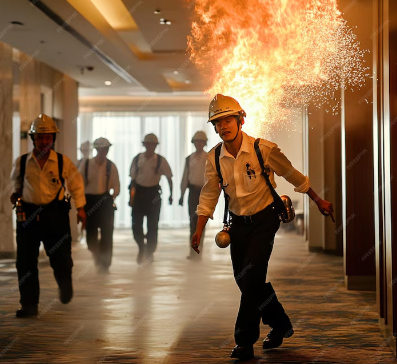How Commercial Fire Services Have Prevented Major Disasters
In commercial settings, fire safety is essential for securing lives, preserving property, and maintaining company operations. Commercial fire services have been crucial in averting significant catastrophes throughout the years; several case studies and technological developments in fire safety have attested to this fact. This article examines the ways in which these services have effectively reduced risks and avoided disastrous occurrences.

Advanced Fire Detection Systems
The creation of advanced fire detection systems is one of the major technological advances in fire safety. Oftentimes before they are apparent to the human eye, smoke, heat, and flames may be detected early on by modern fire alarms and sensors. For example, a sophisticated fire detection system in a Chicago high-rise office building detected a tiny fire in the electrical panel room, setting off an alarm and alerting emergency personnel before the fire had a chance to spread. Because to the early detection, a prompt response was possible, averting a major calamity that may have damaged many floors and put lives in danger.
Effective Fire Suppression Systems
Advances in fire suppression systems, which are intended to contain or put out flames swiftly, have also been developed by commercial fire services. For instance, sprinkler systems are now more dependable and efficient. In a recent event at a sizable warehouse in Atlanta, a fire started because of a defective piece of equipment, and the sprinkler system responded quickly. In order to save millions in possible damages and stop the fire from spreading to other warehouses, the sprinkler system contained the fire until the fire service arrived.
Comprehensive Fire Safety Training
The foundation of business fire services is fire safety training. Frequent training and exercises guarantee that staff members are prepared to respond in the event of a fire. One famous instance included a chemical accident that resulted in a fire breakout at a Detroit manufacturing factory. Employees successfully carried out their emergency response plan and safely and swiftly evacuated the premises as a result of thorough training sessions. Because of their preparation, there was a far lower chance of casualties and less interference with firefighting activities while the firefighters were managing the fire.
Proactive Fire Prevention Measures
Commercial fire services concentrate on proactive fire prevention measures in addition to responding to actual incidents. It is important to conduct routine maintenance and inspections of fire safety equipment and to implement fire prevention measures. One major retail chain, for instance, implemented a strict maintenance plan for its sprinkler and fire alarm systems. What may have been a serious fire threat was avoided when possible problems were found and fixed during a regular inspection.
Collaboration with Local Fire Departments
Fire safety is improved when municipal fire departments and commercial fire services work together. Through cooperative drills and communication procedures, both sides are guaranteed to be well-equipped to handle crises. A retail center in New York recently worked with the neighborhood fire department to organize a full-scale fire exercise. Through this partnership, the fire department’s reaction plans and the mall’s internal fire safety systems were tested and improved, resulting in a more effective and coordinated response in the case of an actual fire.
Implementation of Fire Safety Standards
In order to avert tragedies, compliance with fire safety standards and laws is crucial. Commercial fire services ensure that establishments adhere to regional fire regulations and standards, which frequently call for the use of fire-resistant construction materials, well-marked escape routes, and correctly fitted fire alarms and extinguishers. Silicon Valley’s high-tech laboratory was spared from impending calamity because it complied with all fire safety regulations, which included employing fire-resistant materials and allowing emergency personnel unobstructed access. When a fire did break out, these steps assisted in keeping it contained and limited the damage.
Lessons Learned and Continuous Improvement
Every fire event teaches important lessons about enhancing fire safety procedures. Commercial fire departments review historical data to improve their tactics and equipment. For example, following a fire at a Texas data center, fire services investigated the event to determine what went wrong. To stop such incidents from happening again, they put new procedures and technology into place. By using a continual improvement approach, fire safety may be improved overall, and possible dangers can be avoided.
Conclusion
Commercial fire services use cutting-edge technology, efficient training programs, preventative actions, and teamwork to play a vital role in averting catastrophic events. Businesses may lower the danger of catastrophic occurrences and guarantee a safer environment for their workers and assets by investing in these services and following fire safety regulations. The continuous effort to enhance fire safety procedures emphasizes how crucial it is to be ready and watchful while facing any fire threats.
